Dell Studio 17: When Gaming Isn't Enough
by Dustin Sklavos on August 26, 2010 12:10 AM ESTDell Studio 17: A Halfway Decent Screen
This might be a good time to note that Dell offers three different screen types for the Studio 17, and that the one we're reviewing is the low man on the totem pole. You can upgrade to a touchscreen or a 1080p "B+GR" LED backlit screen.
I've had a chance to review standard notebooks with built-in touchscreens before and I've been utterly unimpressed each time. The form factor doesn't seem to lend itself to any kind of useful touch-based interaction, and so the touchscreen that puts a $400 premium on the Best Buy unit available is probably not worth it. Those of you itching for a 1080p screen, however, will probably do well to go with the Dell "B+GR" upgrade.
One major drag in the industry is the fact that you pretty much have to buy a 17" notebook to get a screen with a higher resolution than 1360x768 for a reasonable price. That low resolution wasn't even the result of customer feedback, it was just foisted on us because it was cheaper and easier to produce 768p screens than the older 1280x800 ones. In the process, they made the screens that much less useful for doing media work, where vertical real estate can often be even more important than horizontal (timelines don't exactly run vertically).
Oh yeah, we were reviewing the screen on the Studio 17.
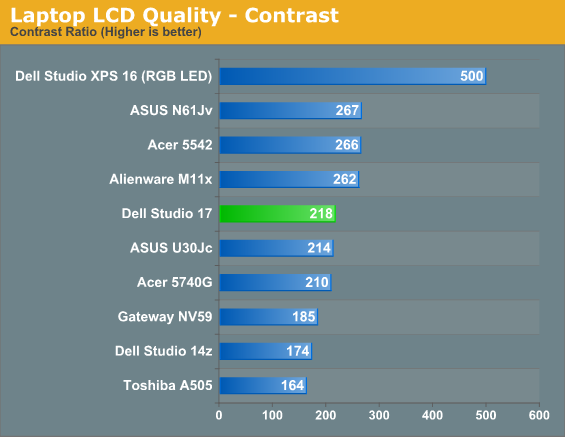
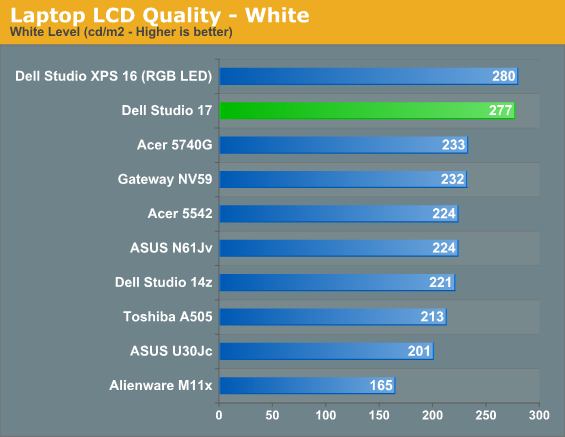
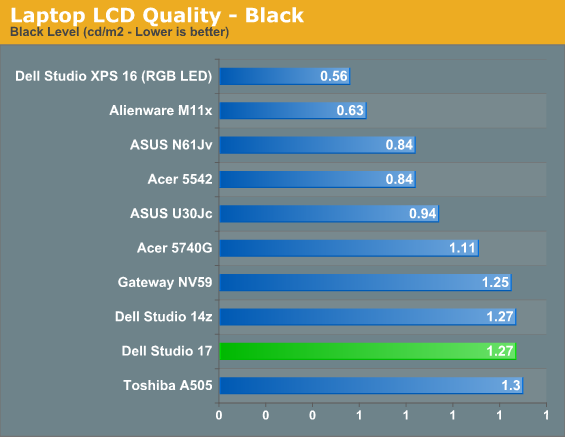
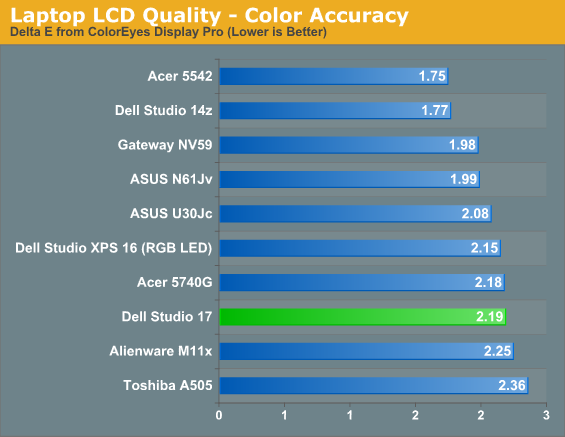
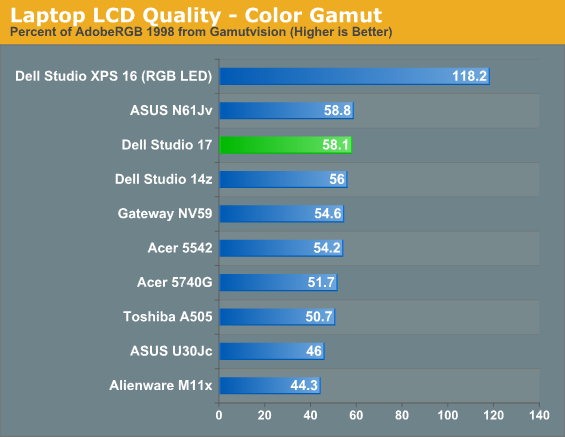
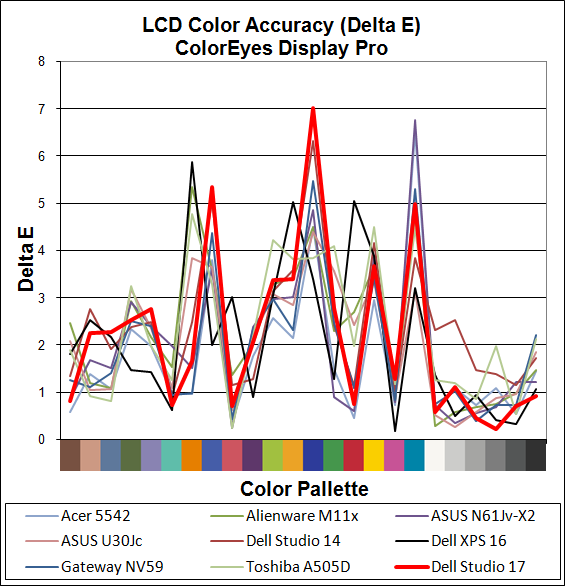
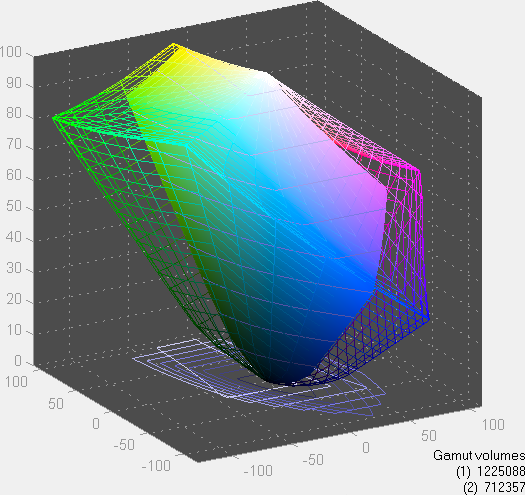
So the "halfway decent" part of the display is that it's reasonbly bright and isn't saddled with a low 768p resolution, but then most 17.3" LCDs are at least 900p. The color accuracy is about par for the course, and color gamut is okay as well. The contrast and black ratio are, as is so often the case, where the LCD falls flat. 200:1 contrast ratios aren't even remotely acceptable on high-end laptops, though with a price south of $1000 we can't complain too much here. The 1080p upgrade should be quite a bit better, and if that's what you're after we certainly recommend spending the $150 to move to the B+RG panel. Note that there's a $25 upgrade 1080p panel available as well, but we suspect contrast will take a dive there just like the 900p default display.










41 Comments
View All Comments
SteelCity1981 - Thursday, August 26, 2010 - link
Intel Core i7-720QM(4x1.6GHz, 45nm, 8MB L3, Turbo to 2.8GHz, 45W)
It should be....
Intel Core i7-720QM
(4x1.6GHz, 45nm, 6MB L3, Turbo to 2.8GHz, 45W)
The Intel Core i7-72xQM series use only 6MB of L3 cache.
JarredWalton - Thursday, August 26, 2010 - link
Fixed.InternetGeek - Thursday, August 26, 2010 - link
Hi Guys,I noticed the benchmarks do not include the HP Pavillion 17". Is it because it was too slow or just not available for the benchmarks?
Still reading the review...
JarredWalton - Thursday, August 26, 2010 - link
It's a case of reviewing what we've received... or in this case, what Dustin bought for himself. The reason he didn't even consider the Pavilion 17 is because he's a multimedia (video) user. He wanted quad-core i7, but he also needs Firewire support and would really like ExpressCard/34 as well. The Pavilion 17 lacks both features.kmmatney - Thursday, August 26, 2010 - link
I would love to get a new laptop, but my current Dell, which is over 3 years old, has a 17" 1920 x 1200 screen. Giving up those 300 vertical pixels is going to suck. I really wish they would go back to 16:10 screens, at least for laptops.I have to say my Dell Inspiron 9400, with a merom T7200, has been very good. It has taken a tremendous amount of travel and abuse (a 6 foot drop onto a concrete floor once) and has held up well. My next machine will be another Dell laptop, if I can help it, but I really hate the vertial screen resolutions.
B3an - Thursday, August 26, 2010 - link
If you read the display page you would have seen that you can choose a 1080p res display. Still less pixels but not many.I agree about 16:10, it's much better.
Nfarce - Thursday, August 26, 2010 - link
That's exactly what he's referring too (as I did below): 1920x1080 vs. 1920x1200.Oh and one other thing I forgot to mention for comparison's sake to the older Dell Inspirons of 2006-2007 E-series: even a 15" E1505 could be optioned with a 1920x1200 high resolution display.
Nfarce - Thursday, August 26, 2010 - link
I agree w/kmmatney. I also have a 17" Inspiron (E1705 that's 4 1/2 years old now with ATi x1300 and T7200). It ran the older games like HL2 and Return To Castle Wolfenstein great at 1920x1200. I still use it as a gaming machine for older games when I get the nostalgic feeling. But the days of 1920x1200 are drawing to a close even for regular LCDs, of which I have a 26" Samsung. Everything nowadays is at 1920x1080. Can anyone offer a logical explanation for that? I'm really bothered by this because I use Microsoft FSX a lot and 16x9 aspect resolution pinches the cockpit gauges somewhat.JarredWalton - Thursday, August 26, 2010 - link
Logical? Well, it's simply a case of the LCD panel makers being able to get more displays out of a sheet of glass substrate with 16:9 than with 16:10. If you do the math, of course, a 17" 16:10 panel is around 130 in^2 and a 17.3" 1080p panel is 128 in^2, but the glass sheets they're made from (with all the LCD circuitry and such) may be better sized for the wider+narrower panels.The other side of the equation is that with movies going widescreen, and the push for PCs to become more multimedia capable, WS displays make sense. That doesn't mean 16:9 is better than 16:10, but in some marketing departments....
erple2 - Thursday, August 26, 2010 - link
<quote>The other side of the equation is that with movies going widescreen, and the push for PCs to become more multimedia capable, WS displays make sense.</quote>Normally, I'd agree, but movies are generally far more than 16:9 AR. They're generally in the anamorphic (2.33:1) or 1.87:1 (not the 1.78:1, aka 16:9).
I think that your second guess (that the glass made for LCD panels lends itself better to 16:9) is probably the right one. I also suspect that became a circular "problem" - Someone somewhere decided to try 16:9 instead of 16:10, marketed that as the AR used for HD (720p or 1080p), then found out it was cheaper to make (for the same "size"), then stuck with it.